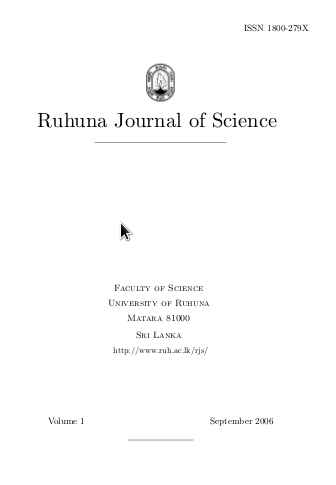A simple device to reduce the wastage of cooking gas
Abstract
We have invented a simple device to reduce the wastage of cooking gas. The main objective is to reduce the energy loss to the surroundings due to convection, radiation and conduction from pans with spherical bottoms like thachchiya used in cooking traditional food such as hoppers. In particular, the heat loss to the surroundings between the burner and the surface of the cooking pan is considered here. The efficiency of the device is compared with that of the bare pan by measuring the time taken to boil a fixed amount of water while keeping other conditions the same. The result indicates that the device reduces the gas consumption by about 23%. The device can be easily manufactured locally at low cost for practical applications.References
Cleovoulou M. 1997. Introducing fuel-saving cooking methods in southern Tamil Nadu, http://www.cleovoulou.com/fuelsave.htm
Cleovoulou M. 1998. Introducing fuel-saving cooking methods in northern Ghana, http://www.cleovoulou.com/fsghana.htm.
Arnold B. 1980. Rediscovery the Hay-Box cooker, Mother Earth News, No. 61.
Cureton M. 1995. Inefficient home appliances may be stealing your water, rob-bing your electricity and assaulting your pocketbook. Rocky Mountain Institute, http://www.sdearthtimes.com/ et0595/ et0 95s1.html
Ranatunga EM. Dharmaratna WGD. 2006. A simple device to use cooking gas efficiently, (preliminary results in abstract form), accepted for SLAAS 2006.
Downloads
Published
Issue
Section
License
From Volume 7 (2016) onwards, all articles published in Ruhuna Journal of Science are Open Access articles published under the Creative Commons CC BY-NC 4.0 International License. This License permits use, distribution and reproduction in any medium, provided the original work is properly cited and is not used for commercial purposes.
Copyright on any research article published in RJS is retained by the respective author(s).
Authors who publish with this journal agree to the following terms:
a) Authors retain copyright and grant the journal right of first publication with the work simultaneously licensed under a Creative Commons Attribution License CC-BY-NC 4.0 International, that allows others to share the work with an acknowledgement of the work's authorship and initial publication in this journal.
b) Authors are able to enter into separate, additional contractual arrangements for the non-exclusive distribution of the journal's published version of the work (e.g., post it to an institutional repository or publish it in a book), with an acknowledgement of its initial publication in this journal.
c) Authors are permitted and encouraged to post their work online (e.g., in institutional repositories or on their website) prior to and during the submission process, as it can lead to productive exchanges, as well as earlier and greater citation of published work (See The Effect of Open Access).

